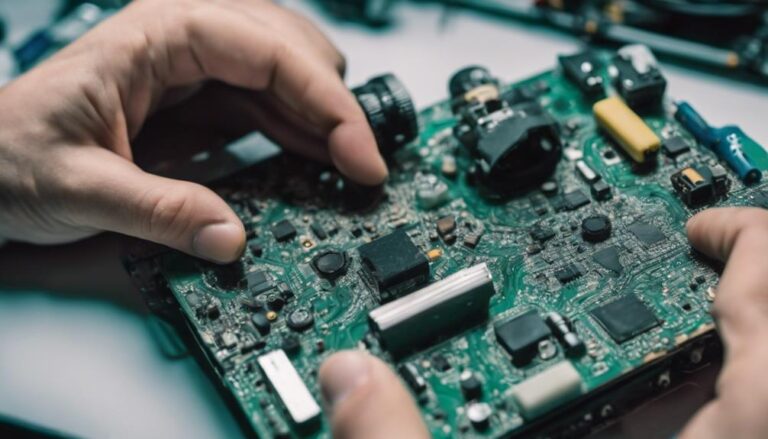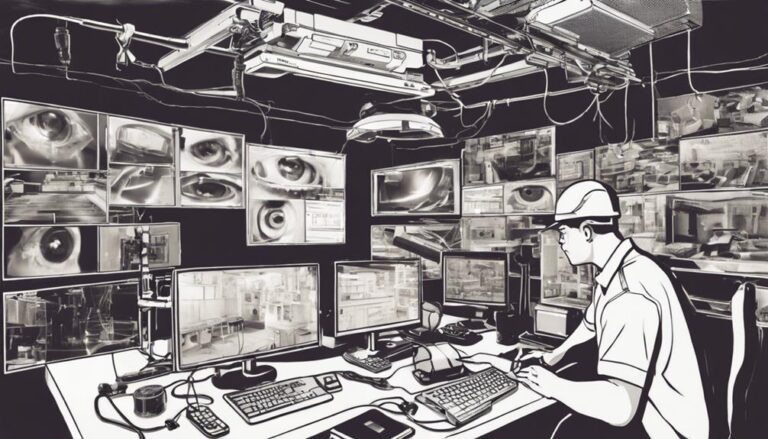Ensuring night vision camera flickering starts by identifying when and where the flicker happens and considering environmental factors like lighting changes. Guarantee the power supply is stable; weak batteries or mismatched adapters can cause flickering. Inspect all camera connections for secure, undamaged cables. Adjust lighting conditions and try adding controlled light sources. Updating your camera’s firmware can resolve bugs that may cause flicker. Optimize settings by adjusting the frame rate and infrared mode, and check for interference or low-quality cables. Testing with different monitors can also help. Follow these tips, and you’ll find a detailed plan to stop the flicker.
Identify the Flickering Issue
To identify the flickering issue in your night vision camera, first observe when and where the flickering occurs. Is it happening at a specific time or in a particular spot? Pinpointing these details can help you figure out what’s going wrong. You crave the freedom to move around without worrying about your camera’s performance, so let’s get to the bottom of this.
Start by considering environmental factors. Is there a sudden change in lighting conditions? Nearby streetlights, headlights, or even moonlight can mess with your night vision. Any reflective surfaces around can also play tricks on the camera sensor, causing it to flicker.
Next, think about sensor calibration. A well-calibrated sensor is essential for peak performance. If your camera’s sensor isn’t properly calibrated, it could be overly sensitive to minimal light changes, resulting in flickering. Manual calibration might be necessary to adjust the sensitivity settings.
Check Power Supply
A stable power supply is crucial for preventing flickering in your night vision camera. When you’re out there capturing the world in the dark, the last thing you need is your camera acting up because of power issues. Start with a battery check. Make sure your batteries are fully charged and capable of delivering consistent power. Weak or old batteries can cause voltage drops, leading to that annoying flicker.
Next, consider voltage regulation. Your camera’s performance can be compromised by fluctuations in power. If you’re using a power adapter, make certain it matches the camera’s requirements. An adapter with the wrong voltage can wreak havoc on your tech. If you’re relying on battery packs, check if they’re providing a steady voltage. Sometimes, investing in a voltage regulator can save you a lot of headaches by maintaining a consistent power flow.
Inspect Camera Connections
Inspecting your camera connections is another crucial step in solving flickering issues. A loose or frayed cable can wreak havoc on your night vision camera’s performance. Here’s what you need to do to guarantee cable integrity and connection stability:
- Check All Connections: Make sure each cable is firmly plugged into the camera and any supporting devices. A loose connection can cause intermittent power loss, leading to flickering.
- Inspect Cable Integrity: Look for any signs of wear and tear along the cables. Frayed or damaged cables can disrupt the signal and power supply, causing instability. Replace any compromised cables immediately.
- Secure Connections: Use cable clips or ties to secure connections, preventing them from being accidentally tugged or disconnected. This simple step can drastically improve connection stability.
- Test Each Connection: If possible, test each connection with a multimeter to guarantee there are no breaks in the wiring. Any break, no matter how small, can disrupt the flow of power and data, leading to flickering.
Adjust Lighting Conditions
Although it might seem counterintuitive, adjusting the lighting conditions around your night vision camera can greatly reduce flickering. This might make you feel like you’re compromising the camera’s purpose, but a little tweak in the ambient brightness can work wonders. For instance, increasing natural lighting during the day can help the camera switch more smoothly to night mode, minimizing that annoying flicker.
Start by evaluating the area where your camera is installed. Is there a way to increase or manipulate natural lighting? Maybe a small outdoor light fixture could make a huge difference. Experiment with different levels of ambient brightness to find the sweet spot where the camera performs best.
You’re not tied to the idea that night vision means absolute darkness. Embrace the freedom of flexibility. Add a bit of controlled light to the environment. This could mean soft lighting around entryways or even motion-activated lights that provide just enough illumination without overpowering the camera’s night vision capabilities. You’re in control of the lighting conditions, and adjusting them can greatly enhance your camera’s performance, making flickering a thing of the past.
Update Camera Firmware
Updating your camera’s firmware can often fix flickering issues. First, check the current firmware version on your camera. Then, download the latest update from the manufacturer’s website to guarantee your camera operates smoothly.
Check Firmware Version
To address flickering issues with your night vision camera, start by checking the firmware version to see if an update is available. This is an important step because outdated firmware might be causing compatibility issues. Updating the firmware can often resolve these problems without needing alternative methods.
Here’s how you can check your camera’s firmware:
- Access Camera Settings: Open the app or interface where you manage your camera settings. This could be a mobile app or a web-based portal.
- Locate Firmware Information: Find the section that displays the current firmware version. This is usually under ‘About’ or ‘Device Information’.
- Compare Versions: Check the manufacturer’s website or support page to see if there’s a newer firmware version available. Make sure your current version isn’t the latest one.
- Verify Compatibility: Make sure that any new firmware updates are compatible with your specific camera model to avoid potential issues.
Download Latest Update
Downloading the latest update for your night vision camera can help eliminate flickering by making sure you have the most recent fixes and improvements. Your camera’s firmware acts as its brain, and updating it can resolve bugs, enhance performance, and integrate the latest security updates to keep your system safe and reliable.
First, determine the update methods available for your specific camera model. Some cameras allow you to update firmware directly via a mobile app or web interface. This method is often user-friendly and requires just a few taps or clicks. Alternatively, other cameras may need you to download the firmware update from the manufacturer’s website and then manually upload it to the camera via a USB connection or memory card.
Whichever method you choose, make certain your camera is powered during the update to prevent any interruptions. Losing power mid-update could cause significant issues, possibly even bricking your device. Once the update is complete, restart your camera to apply the changes.
Modify Camera Settings
To address flickering issues, you’ll need to tweak some camera settings. Start by adjusting the light sensitivity and changing the frame rate. Additionally, configuring the infrared mode can greatly enhance night vision performance.
Adjust Light Sensitivity Settings
When your night vision camera starts flickering, adjusting the light sensitivity settings can often resolve the issue. It’s time to take control of your camera’s performance and make sure it operates smoothly, even in low light conditions. Start by diving into the settings menu and fine-tuning the sensor calibration and gain control.
Here’s a straightforward approach to get you started:
- Access Camera Settings: Navigate to the camera’s settings menu. This is usually accessible via the camera’s app or a web interface.
- Adjust Sensor Calibration: Look for options related to sensor calibration. Fine-tuning this can help the camera better interpret varying light conditions and reduce flickering.
- Modify Gain Control: Gain control settings adjust the camera’s sensitivity to light. Decrease the gain if the image is too bright or increase it if it’s too dark. This balance is important for clear night vision.
- Test and Observe: After making these adjustments, observe the camera’s feed to check if the flickering has stopped. If not, you may need to tweak the settings further.
Change Frame Rate
One effective way to combat night vision camera flickering is by delving into the camera settings and adjusting the frame rate. When your camera’s frame rate doesn’t sync up with the lighting frequency, it can lead to synchronization issues, causing that annoying flickering you’re trying to eliminate. Tweaking the frame rate can help you achieve smoother footage and free you from the headache of constant flicker disruptions.
To do this, explore your camera’s settings. Look for the frame rate option—typically measured in frames per second (fps). If your camera is set at 30 fps, try switching it to 25 fps or vice versa. This small change can often resolve flickering caused by lighting frequencies that clash with your camera’s frame rate.
Another technique to explore is frame blending. Some cameras have an option to blend frames together, which can smooth out the flickering effect. This isn’t a catch-all solution, but it’s worth exploring if changing the frame rate alone doesn’t do the trick. Remember, you’ve got control over your setup, and tweaking these settings can greatly enhance your night vision footage, letting you enjoy the freedom of seamless video recording.
Configure Infrared Mode
Configuring infrared mode is another essential step in addressing night vision camera flickering. When your camera’s infrared settings aren’t optimized, you might experience disruptions in the footage. By adjusting these settings, you can guarantee smoother, flicker-free night vision.
- Access Camera Settings: Start by accessing your camera’s settings menu. Look for options related to night mode or infrared settings.
- Enable Infrared Calibration: Many cameras offer an infrared calibration feature. Make sure this is enabled to allow the camera to automatically adjust infrared levels based on ambient light.
- Adjust Infrared Sensitivity: Some cameras allow you to manually adjust the infrared sensitivity. Lowering this sensitivity can reduce flickering, especially in environments with fluctuating light sources.
- Schedule Night Mode: Set your camera to switch to night mode at specific times. This helps the infrared system to stabilize before it gets dark, reducing flicker chances.
Examine Interference Sources
To pinpoint the cause of night vision camera flickering, start by checking for any electronic devices nearby that might be causing interference. Wireless interference from routers, smartphones, and other wireless devices can disrupt the camera’s signal. Electromagnetic interference from appliances like microwaves, cordless phones, and even fluorescent lights can be culprits as well.
You’ll want to create a checklist of potential sources of interference. Turn off or move any wireless devices to see if the flickering stops. If your camera is near a microwave or a large appliance, consider relocating it to a spot with fewer electrical disruptions. The same goes for fluorescent lights; their magnetic fields can wreak havoc on your camera’s night vision capabilities.
Keep in mind, wireless and electromagnetic interferences are often invisible, making them tricky to identify. But don’t let that hold you back. Experiment with different placements and distances for your camera and other devices.
Your freedom to capture clear, consistent night vision footage shouldn’t be compromised by unseen electromagnetic waves. By systematically eliminating sources of interference, you’re taking control and ensuring your camera performs at its best.
Use Quality Cables
Investing in high-quality cables can greatly reduce night vision camera flickering and improve overall performance. When you’re setting up your surveillance system, the quality of your cables is essential. Poor cable quality can lead to signal interference, which is a common cause of flickering. To make sure you’re getting the best performance, consider these four key points:
- Cable Type: Use cables specifically designed for video transmission, like RG59 or RG6 coaxial cables. These are built to handle video signals efficiently.
- Shielding Effectiveness: Look for cables with strong shielding. This protects against electromagnetic interference (EMI) and radio frequency interference (RFI), both of which can cause flickering.
- Connectors: Ensure that the connectors are secure and of high quality. Loose or poor-quality connectors can disrupt the signal and lead to performance issues.
- Length: Avoid unnecessarily long cables. The longer the cable, the more potential for signal degradation and interference.
Test With Different Monitors
When troubleshooting flickering issues, it’s crucial to test your night vision camera with different monitors. This helps to identify if the problem is related to monitor compatibility or display refresh rate. Switching monitors could reveal if your current display isn’t best suited for the camera’s output.
Monitor Compatibility Check
Although your night vision camera may seem to be the problem, it is crucial to test it with different monitors to rule out any compatibility issues. Often, the flickering you experience could be due to mismatched resolution settings or signal compatibility problems between your camera and monitor. Testing your camera with various monitors can help you identify if the issue is with your current setup or the camera itself.
Here’s a simple approach to make sure you’ve covered all bases:
- Try Different Monitors: Connect your camera to several monitors with varying brands and models. This will help you see if the flickering persists across all devices.
- Check Resolution Settings: Verify that the resolution settings on each monitor match the output resolution of your night vision camera. Mismatched settings can lead to image distortion and flickering.
- Assess Signal Compatibility: Confirm that the signal type (analog or digital) your camera outputs is compatible with the monitor’s input. Some monitors might not support certain signals, causing flickering issues.
- Use Quality Cables: Low-quality or damaged cables can also introduce flicker. Swap out cables to see if that resolves the issue.
Display Refresh Rate
To ensure that your night vision camera performs at its best, it’s essential to evaluate its compatibility with different display refresh rates on various monitors. Flickering often results from a mismatch between the camera’s output and your monitor‘s refresh rate. By experimenting with various screens, you can identify the ideal setup that minimizes or eliminates flickering.
Start by adjusting the screen resolution on your monitor. Higher resolutions may introduce more flickering, while lower resolutions can sometimes reduce it. Once you’ve found a suitable resolution, move on to refresh calibration. Most monitors offer settings to change the refresh rate, typically ranging from 60Hz to 144Hz. Try different rates to see which one works best with your night vision camera.
Don’t forget to take into account the type of monitor you’re using. Some monitors have better refresh calibration capabilities, especially gaming monitors designed for high performance. If you have access to multiple monitors, test your night vision camera with each one to see which combination offers the smoothest display.
Consult Technical Support
If the flickering persists despite your troubleshooting efforts, it’s best to consult technical support for expert assistance. Sometimes, even with all the right knowledge and tools at your disposal, a professional touch is necessary to get your night vision camera working correctly. Here’s how you can make the most out of technical support:
- Review Extended Warranty: Before reaching out, check if your camera is still under an extended warranty. This can save you from additional costs and might even expedite service.
- Gather Information: Have your user manuals, purchase receipts, and any previous correspondence ready. This information will help the support team diagnose the issue more efficiently.
- Document the Issue: Take note of when the flickering occurs, any patterns you’ve observed, and any steps you’ve already taken to try and fix it. This will provide a clear picture to the support team.
- Contact Support: Reach out to the manufacturer’s support team through their official channels. Be prepared to follow their guidance, which might include running specific tests or sending the camera in for repairs.
Frequently Asked Questions
What Causes Night Vision Cameras to Flicker in Low-Light Conditions?
Oh, the joy of flickering! It’s often due to infrared interference or an unstable power supply. Nothing like a camera glitch to remind you how much you cherish your freedom to troubleshoot tech issues yourself, right?
Can Weather Conditions Affect Night Vision Camera Performance?
Yes, weather conditions can affect night vision camera performance. Temperature fluctuations can cause condensation, and humidity impacts the camera’s electronics. Don’t let poor weather restrict your freedom—ensure your camera’s weatherproof and well-maintained.
How Can I Prevent Future Flickering in My Night Vision Camera Setup?
You don’t want flickering ruining your footage, do you? Guarantee a stable power supply and regularly check for software updates. This gives you the freedom to enjoy seamless surveillance without the hassle of interruptions.
Are Certain Brands of Night Vision Cameras More Prone to Flickering?
Yes, some brands are more prone to flickering. Check brand reputation and product reviews before buying. You don’t want to feel restricted by poor quality, so choose a reliable brand to enjoy hassle-free surveillance.
Do Wireless Night Vision Cameras Flicker More Than Wired Ones?
Absolutely, wireless night vision cameras can flicker more than wired ones. Signal interference is a major culprit, and battery life issues can exacerbate the problem. If you crave freedom, consider these factors before choosing a camera.



